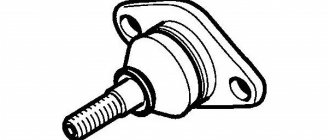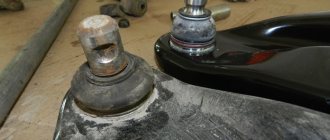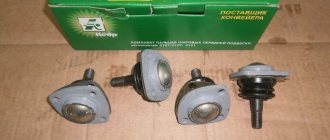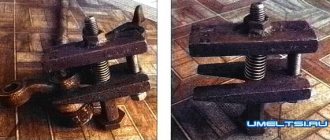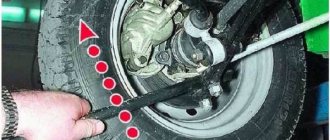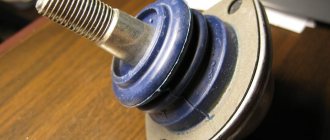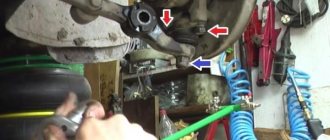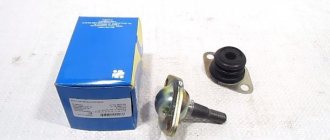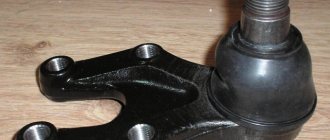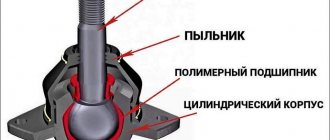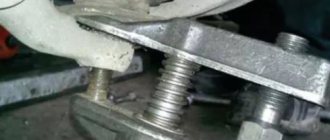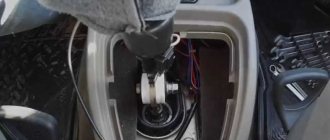If you experience knocking noises from the front suspension, especially when driving on an uneven road with small holes or potholes, you should pay attention to the condition of the ball joints. On a Grant, factory ball joints can easily travel more than 100,000 km during normal operation, but there are also cases when this has to be done much more often. It is for such cases that this article will be written.
In order to replace the ball joints on the Grant, we will need the following tool:
- Hammer
- Mount
- Puller
- Key for 17 and 19
- Torx head e12
- Ratchet or crank
Photo report on replacing ball joints on Lada Granta
The first thing you need to do is put the car on a lift or jack up the front of it. After this, remove the wheel to gain access to the front suspension elements.
Then unscrew the two bolts securing the support to the steering knuckle, as shown in the photo below:
Then, using a 19mm wrench, we tear off, but do not completely unscrew the lower nut attaching to the front suspension arm of the Grant:
And now you can use a special puller to press the ball joint pin out of the lever, or use a hammer and pry bar for this purpose.
After removing the finger, you can remove the support completely, move the lever to the side:
If it is not possible to move the lever to the side using a pry bar, then you can use a jack and a brick, as is clearly shown in the photo below.
We take a new ball, remove the boot and thoroughly push it inside with lubricant, such as Litol. After which you can install the new ball in its place. Of course, you will have to suffer quite a bit until the support gets into place, but if you have a jack and pry bars, everything can be done without any problems.
We tighten all the bolts and nuts to the required torque and put all the other parts in their places. With this, we can consider this repair of the Lada Granta complete. The price of a new ball joint is no more than 400 rubles for the original product from AvtoVAZ. There are cheaper options, but in this case you can save on both price and quality!
Source: https://avtozam.ru/vaz/zamena-sharovoj-lada-granta-vaz-granta.html
Ball joint versus kingpin: an unequal fight
The ball joint is an integral part of the suspension of a modern car. It is what connects the wheel hub and levers, allowing it to rotate normally and simultaneously turn left and right.
This part is mainly used in the front suspension of cars, but similar functionality can be found in other components.
For example, in the steering mechanism or even in the fastenings of the hood gas stops.
In fact, the ball joint was not always an integral attribute of the chassis system.
At the dawn of the automotive industry, and, frankly speaking, until the 60s of the last century, its functions were performed by the so-called pivot mechanism.
In fact, it was a rod to which the rotating axle of the wheels was attached. It was an elementary and uncomplicated mechanism, but it could not withstand competition with the emerging ball counterparts, which had a number of important advantages, namely:
- durability;
- ease;
- no need for constant lubrication and maintenance;
- the presence of a greater number of degrees of freedom, because they are based on a spherical joint, which can not only rotate in a horizontal plane, like a pin, but also work out other degrees of freedom without any problems.
In a word, with his appearance in the automotive world, our today's hero made a small revolution, freed the hands of mechanical engineers and allowed them to implement new solutions in suspensions that improve the driving characteristics of cars and our comfort.
Successful design is the key to success
So, it’s time to find out what the secret of the ball joint is, and to do this, let’s look at its design. Let's be honest - there is nothing supernatural in it, and on the contrary, it is an extremely simple mechanism.
The average ball joint of a modern car consists of the following elements:
- a rod with a spherical tip on one side and an element for fastening to the suspension arm on the other;
- cylindrical metal body;
- polymer liner;
- a pressure washer that secures the previous part in the body;
- boot - a rubber shell that ensures its tightness.
As we can see, there is nothing complicated, and the attached illustration quite clearly lets us understand how everything works.
Modern ball joints are consumables, that is, they are maintenance-free and, in the event of failure, can only be replaced.
Previously, designers took a more rational approach to these parts, and provided them with special holes through which lubricant could be pressed inside, but nowadays this is irrelevant, because thanks to the high-strength plastics used for the liners, these suspension elements can travel up to 150 thousand kilometers without any problems .
Problems when paying with bank cards
Sometimes difficulties may arise when paying with Visa/MasterCard bank cards. The most common of them:
- There is a restriction on the card for paying for online purchases
- A plastic card is not intended for making payments online.
- The plastic card is not activated for making payments online.
- There are not enough funds on the plastic card.
In order to solve these problems, you need to call or write to the technical support of the bank where you are served. Bank specialists will help you resolve them and make payments.
That's basically it. The entire process of paying for a book in PDF format on car repair on our website takes 1-2 minutes.
Unlike the front, it has undergone virtually no changes. Here, just like on the first Soviet G8s, a semi-independent beam is used. It is attached to the body on hinges (fortunately, there are no “crabs” in the design). A helical spring with constant stiffness is used as an elastic element. To dampen vibrations and prevent swinging, two shock absorbers are used.
- High reliability. The design does not have additional levers, which, in addition, can bend when falling into a large hole.
- Energy intensity. The Lada Granta absorbs all bumps perfectly, especially if oil shock absorbers are installed at the rear.
- Cheap maintenance. Due to its simple design, this pendant can be rebuilt even with your own hands. And the cost of new rubber-metal elements is unlikely to empty the pockets of even the most stingy car owner.
The main difference between the “Grant” suspension is the wheel alignment angles.
Malfunctions and their symptoms
Of course, ball joints do not always please their owners with impeccable performance over hundreds of thousands of kilometers. Sometimes they feel bad much earlier. What could be the reason? As a rule, there are three of them:
- increased shock loads - quite logically, the ball and many other parts of the chassis will become uncomfortable if you desperately jump the car over bumps, dive into holes or otherwise test its strength;
- drying out of the lubricant - this is why these parts used to be serviceable, but nowadays this reason is not very common;
- destruction of the anther and, as a result, loss of tightness. In turn, dust and dirt get inside the unit, destroying it.
Certain symptoms may indicate that you are waiting for a ball joint replacement, which simply cannot be ignored. Among them are:
- knocking when driving over uneven surfaces at low speed;
- squeaks when turning the steering wheel;
- unstable behavior of the car when driving straight;
- increased tire wear.
Of course, these signs do not always indicate problematic ball joints, but, in any case, when they appear, you need to immediately go to a service station, where experienced technicians will be able to make a final and correct diagnosis.
That's all, friends. Enjoy your trips, healthy and obedient cars! Don't miss new publications!
Required tools and materials for replacement
To independently replace the ball joint on a Lada Granta car, you need the tools from the list below.
Table - Tools and materials required to replace the ball joint.
| Name | Note |
| Socket head | Torx E12 |
| Vorotok | Under the end cap |
| Ball joint remover | Makes it easier to remove the ball joint from its seat |
| Balloon wrench | For dismantling and installing wheels |
| open-end wrench | "at 17", "at 19" |
| Hammer | Required if you do not have a ball joint remover |
| Jack | To lift the car |
| Wheel chock | For fixing the rear axle |
| Penetrating lubricant | To make it easier to unscrew stuck threaded connections |
| Grease | To fill the boots in case the manufacturer has supplied too little lubricant |
| Rags and wire brush | For cleaning fasteners and working surfaces |
Ball joint device
The device is quite simple. There are several design elements:
- A metal rod or "finger" with a ball-shaped end on one side and a thread on the other.
- Anther. A rubber elastic element that makes the rod work airtight.
- Metal cylindrical body, with a narrow opening on one side and a wide one on the other
- A polymer liner, usually consisting of two parts - the bottom (cup) and the top (stop).
- Pressure washer. Secures the polymer liner.
- Rolling the washer clamp. Essentially, this is the bottom of the ball joint.
This is such a simple device. A polymer liner is installed in the body, after which the finger is immersed in it, the spherical stop remains in the polymer. Next, we cover the metal ball with the second part of the polymer - it turns out to be pressed on both sides. Then close with a pressure washer and seal the bottom. It needs to be very tightly closed in plastic (polymer) cases, so tightly that there is not even the slightest play (it is absent as a class). A boot on top is also required; it significantly extends the service life of the support.
Front suspension components Lada Kalina, Granta
The front suspension of the Lada Kalina/Granta VAZ-2190 is independent, with telescopic swivel struts, wishbones, longitudinal bracing arms and a torsion-type anti-roll bar.
The front suspension strut consists of a housing in which a hydraulic telescopic coil spring shock absorber and an upper support are installed. A bracket for attaching the steering knuckle, a swing arm and a lower spring support cup are welded to the outside of the strut body.
Depending on the vehicle configuration, the strut may have a barrel-shaped or conical spring. The spring's lower coil rests against the lower support cup, and its upper coil rests against the upper support cup mounted on the shock absorber rod.
Also on the Lada Granta/Kalina shock absorber rod there is an upper strut support, consisting of a housing, a rubber cushion and a bearing. The support body is attached to the car body with three studs and nuts.
How does it work?
As you understand, a closed “ball” can rotate in any direction, even spin. A fixed mount is attached to the cylindrical body, which is installed in the necessary suspension elements - this part is not movable. But the upper threaded pin is attached to the moving parts, thanks to which they can turn or even rotate.
In old rear-wheel drive cars, for example our VAZs, there were about 3 ball joints. Two were located in the burdocks and allowed the caliper to rotate along with the wheel. One was located in the steering rod and pushed the wheels.
The MacPherson suspension has greatly simplified the design. Here, as we know, there is a support bearing and it allows the strut and caliper to rotate, but the ball joint remains at the bottom. There are also steering links that push the calipers, causing the wheels to turn. There are only two ball joints here.
It is also worth mentioning that there are options with four supports, but they are quite rare and should not be considered.
Now there may be objections - that the ball joint and the steering tip are not the same thing. Guys, the only differences are in the mounting of the case, the essence of the work is the same.
If we summarize the work, the following comes out: you turn the steering wheel, the force passes through the steering rack to the caliper, and in order for it to turn, hinge joints are needed, this is exactly the work that the supports, steering tips and, of course, the support bearing do.
Ball selection, articles
The choice of ball joints for the Lada Kalina should be treated carefully, since it determines what loads the car can withstand:
Original
If you believe the spare parts catalog, then the original catalog number of the Lada Kalina ball joint is 2108-2904185 . The average cost is 1000 rubles per piece.
Analogs
Let's consider possible options for replacing the original spare part:
As you can see from the table, you can buy an analogue cheaper than the original. But don’t go to extremes and buy the cheapest.
Failure and resource
The resource directly depends on the polymer liner inside; if it breaks, the metal finger begins to move and finishes off the plastic. Knocks and clicks appear on bumps and turns. However, with the development of polymer technologies, the service life of this part has increased significantly, I remember on our rear-wheel drive VAZs, this was one of the weak points, the “ball” ones were changed after 20 - 30,000 kilometers. With front-wheel drive, on an average foreign car, these elements can travel for 150,000 kilometers; of course, it all depends on the road surface and the driver’s driving style. But progress is obvious, the resource has been significantly increased. It is recommended to check the ball and steering joints at 75,000 kilometers or at the fifth maintenance.
The main reason for failure is the breakthrough of the boot; as soon as it fails (it simply breaks), sand, dirt and other “delights” of our roads immediately get into the hinge joint - they act on the polymer inside like an abrasive, and the metal ball some only aggravate the situation by rubbing particles of sand and dirt with force.
Shock absorber
This element is a damping device. The shock absorber serves to reduce the range of vibrations of the car body. In other words, the element prevents spontaneous rocking. The work of the shock absorber is based on hydraulic resistance. Inside it there is a liquid of a certain viscosity. It moves through a special valve. Thus, the device absorbs sharp impacts while preserving vulnerable suspension parts. Therefore, the shock absorber is one of the most important components in the chassis. On our roads, this element lasts about 60-80 thousand kilometers. But this period may be shorter, even with careful driving. It is enough just to damage the protective boot, and all the dirt will accumulate in the rod seal.
Also note that the damping element changes in pairs. That is, in the event of a breakdown of the rear left shock absorber, the rear right shock absorber also changes. As for the front struts, they are more durable. Often they are replaced already assembled with a spring, since they fail no earlier than after 150-200 thousand kilometers.
vote
Article rating
Replacement or repair
It is quite easy to diagnose failure - firstly, knocks and squeaks appear when turning the steering wheel and driving on poor road surfaces. Secondly, we go to a service station, where the master takes a “mounting rod” or a crowbar, inserts it between the support or “steering” and the lever (caliper body) begins light movements. If the “ball” is working, then it will not knock; if it is broken, play will appear - a replacement is needed.
Of course, you can simply replace the support, this is the easiest way and, in my opinion, the correct one. It doesn’t cost that much money, so once in 100,000 you can go broke. It’s better to change them in pairs at once, that is, if one “ball” rattles, then you should replace two at once, that’s right. Moreover, after replacing them, it is advisable to do a wheel alignment.
However, the most economical ones are looking for repair solutions - and they find them. I remember in Soviet times, when there was a shortage of spare parts, ball joints were successfully repaired. Moreover, they were already sold with the possibility of repair.
Repair work consists of replacing the polymer insert and installing a new one in its place.
Let me emphasize once again - the old supports were repaired, but the new ones are often not dismountable! Although “traditional craftsmen” cut out the bottom, cut the threads, install new polymer gaskets, put everything back into the body and use it further. It should be noted that there seems to be a sense, such a support turns out to be almost eternal, change the polymer filler after a certain mileage - and that’s ALL! However, not everyone can do it well. But the danger from an incorrectly restored ball joint is much more real - so it’s better to buy original new ones and “don’t worry”! However, your safety and the lives of your loved ones depend on their proper operation.
Now let's watch the video version.
I’ll end here, I think it was useful, read our AUTOBLOG.
( 8 votes, average: 5.00 out of 5)
Wear of suspension elements is usually characterized by the appearance of a knocking sound in the front of the car when driving over small uneven surfaces. It is difficult for an inexperienced motorist to determine by the sound which part has “gone bad” and requires replacement. But you can diagnose the problem yourself if you figure out how to check the ball joint. After all, it is its breakdown that leads to the wheel coming off and an inevitable accident. The wear of other elements - stabilizer seals, silent blocks and bearings is not so critical and allows you to operate the car for some time.
Video
This video shows in detail the design of the ball, what it is used for, etc.
Here you can clearly see how a ball joint works in motion.
How to diagnose the suspension yourself.
Diagnostics of steering tips and balls.
This video shows how to check the suspension.
Checking and replacing the ball joint on a FORD FOCUS 2 / FORD FOCUS 2 car.
The suspension of any car consists of many different parts that have different functions. One of these parts is a ball joint, which is a connecting part that allows the front wheels to rotate in different directions. If a part malfunctions, serious consequences can arise, so we will figure out how to check the ball joint of a VAZ 2107, and what may be needed for this.
The role of support in the suspension and the consequences of failure
The part is a ball pin with a thread at the end, enclosed inside a metal housing. So that it can rotate, a sleeve made of hard plastic (usually fluoroplastic) is installed between the ball and the body. The pin is screwed with a nut to the steering knuckle of the wheel hub, and the part itself is bolted to the suspension arm. To prevent dirt from getting inside the hinge, it is protected on the open side with a rubber or silicone boot.
Note: in some car models, the ball joints are integral with the levers and are also replaced together.
The task of the element is to provide a hinged attachment of the hub to the lever so that it can rotate . That is, the support bears the load from the weight of the car, impacts from the wheel and the impact of friction when turning. Now it becomes clear what the risk of malfunctioning this important part is. First of all, the plastic sleeve wears out, causing the ball to begin to dangle inside the body. If measures are not taken, then on a strong bump the ball pin will pop out of the body, and the wheel will come off along with the hub.
Despite the fact that after separation the ball hub is held on a stand or on a second lever, the wheel becomes uncontrollable. The consequences are unpredictable and depend on the speed of movement at the time of the breakdown. That is why it is important to monitor the condition of these elements and respond in a timely manner to extraneous sounds coming from the chassis. If the first signs of a malfunction of the ball joint appear, it is advisable to check it and clarify the diagnosis in order to replace it with a new one in time.
Lada Granta: preparing the chassis and transmission for winter
October 29, 2013
We check the chassis and transmission every 15 thousand kilometers.
Holding the wheel in a vertical plane, we alternately sharply pull the upper part of the wheel toward ourselves, and the lower part away from us, and vice versa.
We make sure there is no play (knock). If there is a knock on the front wheel, ask an assistant to press the brake pedal. If the knocking noise disappears, it means the wheel bearing is faulty, and if the knocking noise remains, then the ball joint is most likely worn out.
The hub bearings of the front and rear wheels are not adjustable and must be replaced if there is play.
To check the serviceability of the ball joint, insert a mounting blade between the suspension arm and the ball joint housing. Be careful not to damage the ball joint boot.
While pressing the lever with a mounting blade, we monitor the movement of the lever head relative to the ball joint housing.
If there is play in the connection, replace the ball joint.
We check the condition of the protective covers of the ball joints.
We replace ball joints with torn or cracked covers.
To check the silent block of the front suspension arm...
...insert the mounting blade between the body bracket and the lever head...
...and we try to move the lever along its axis and along the axis of the bolt. If the lever moves freely, without effort, it means that the silent block of the lever is badly worn or damaged and needs to be replaced. Tearing, cracking and bulging of the rubber bushing of the silent block are unacceptable.
We check the condition of the silent blocks of the front and rear ends of the guy wires.
Tearing, cracking and bulging of rubber silent blocks are unacceptable.
We inspect the anti-roll bar cushions and the rubber bushings of the stabilizer struts.
If ruptures, cracks or severe deformation are detected on the rubber pads and bushings, they must be replaced.
Lifting the rear wheels one by one, we check the condition of the rear wheel hub bearings. The wheel should rotate evenly by hand, without jamming or knocking.
To check the condition of the silent blocks of the rear suspension arms...
...we insert the mounting blade between the suspension arm bracket and the arm head and try to move the arm in different directions.
If the lever moves freely, without effort, it means that the silent block of the lever is badly worn or damaged and needs to be replaced.
We check the condition of the springs, telescopic struts and shock absorbers of the front and rear suspensions.
The suspension springs must not be damaged. Tearing, cracking and severe deformation of rubber bushings, cushions and compression buffers of shock absorbers are unacceptable.
Liquid leakage from shock absorbers is not allowed. A slight “fogging” of the shock absorber in its upper part, while maintaining the characteristics, is not a malfunction.
If the rubber element of the upper support of the front suspension telescopic strut settles or is destroyed, the support must be replaced.
We check the condition of the hinges and the protective cover of the gear shift rod and jet rod.
Alternately rotating and turning the front wheels (with the front of the car hanging out)…
...we inspect the protective covers of the outer... ...and inner joints of the front wheel drives, checking the reliability of their fastening with clamps.
Covers that are cracked, torn or have lost elasticity must be replaced.
We check that there is no oil leakage from the gearbox through the seals of the internal drive joints. If there is a leak, replace the seals.
- Continuation:
- check the steering
- checking the brake system
- More information about the design, maintenance and repair of Lada Granta can be found in our Wikipedia (link)
Error in the text? Select it with your mouse! And press: Ctrl + Enter Unnamed
Advantages:
Inexpensive, reliable, economical, unpretentious car
Flaws:
Noisiness, windiness, quality of individual components, demonstrative disrespect on the road
Source: https://www.zr.ru/content/articles/585471-lada-granta-gotovim-k-zime-xodovuyu-i-transmissiyu/
